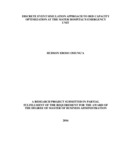| dc.description.abstract | Ambulance diversion and long patient waiting time are two undesirable effects of
emergency department constricted patient flow and indicate a lack of capacity
optimization. On the other hand, capacity optimization for an Emergency Department
(ED) is elusive due to the stochastic nature of patient arrivals, length of stay, service rate
and discharge patterns. The study’s main purpose was to design a Discrete Event
Simulation model that would enhance emergency patients’ bed capacity optimization and
ED throughput management by incorporating the concept of uncertainty in its
predictions. The study pursued the following three specific objectives; to establish
emergency patient arrival and exit patterns at Mater Hospital, to determine the
relationship between emergency patient arrival rate (μ) and the exit rate (ƛ), and to
establish the optimum emergency patient bed capacity for Mater Hospital’s emergency
unit. This was a case study that relied on historical data kept by the hospital to build
probability distributions for patient arrivals, waiting times, service rates and exit rates for
the Emergency unit. The processed probability distributions formed the input data for the
Discrete Event Simulation (DES) model. The DES model was iterated many times (1000)
in order to increase the accuracy of the model output information necessary for decision
making. The model performance accuracy was also measured through the process of
Validation which compared actual data with data from the simulation model using the
student t-test procedure at 95 percent confidence level assuming equal variance. The
study established that patient arrival and exit patterns at the Mater Hospital were highly
random with the arrival rate (μ=3) hovering above the discharge rate (ƛ=2). The mean
patient waiting time dropped from approximately 32 minutes currently to 12 minutes
after introducing efficiency improvements of an additional two patient beds during
simulation.This represents a 60% drop in waiting time. The model was a reasonably
accurate representation of emergency patient flow at the Hospital due to the higher
calculated p-value (p=0.97, d.f=238) than the 0.05 critical value implying the lack of a
significant statistical difference between the actual data and the corresponding simulated
data. Employing Discrete Event Simulation in an Emergency Department of a Hospital
can solve capacity management and flow problems significantly. | en_US |



